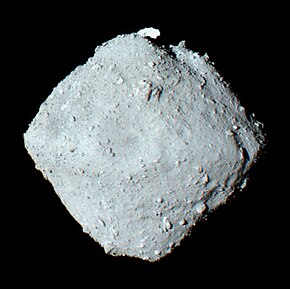 Color image of Ryugu taken by Hayabusa2, 2018 | |
| Discovery[1] | |
|---|---|
| Discovered by | LINEAR |
| Discovery site | Lincoln Lab's ETS |
| Discovery date | 10 May 1999 |
| Designations | |
| (162173) Ryugu | |
| Pronunciation | /riˈuːɡuː/ Japanese: [ɾjɯːɡɯː] |
Named after | Ryūgū[1] ("Dragon palace") |
| 1999 JU3 | |
| Apollo · NEO · PHA[1][2] | |
| Orbital characteristics[2] | |
| Epoch 12 December 2011 (JD 2455907.5) | |
| Uncertainty parameter 0 | |
| Observation arc | 30.32 yr (11,075 d) |
| Aphelion | 1.4159 AU |
| Perihelion | 0.9633 AU |
| 1.1896 AU | |
| Eccentricity | 0.1902 |
| 1.30 yr (474 d) | |
| 3.9832° | |
| 0° 45m 34.56s / day | |
| Inclination | 5.8837° |
| 251.62° | |
| 211.43° | |
| Earth MOID | 0.0006 AU (0.2337 LD) |
| Physical characteristics | |
| Dimensions | 1004 m × 876 m[3] |
| 448±2 m[3] | |
Equatorial radius | 502±2 m[3] |
Polar radius | 438±2 m[3] |
| Volume | 0.377±0.005 km3[3] |
| Mass | (4.50±0.06)×1011 kg[3][4] |
Mean density | 1.19±0.03 g cm−3[3] |
Equatorial surface gravity | 1/80,000 g[4] |
| 7.63262±0.00002 h[3] | |
| 171.64°±0.03°[3] | |
North pole right ascension | +96.40°±0.03°[3] |
North pole declination | −66.40°±0.03°[3] |
| 0.037±0.002[5] 0.042±0.003[6] 0.047±0.003[7] 0.063±0.020[8] 0.07±0.01[9] 0.078±0.013[10] | |
| SMASS = Cg[2] · C[7] · Cb[11] | |
| 18.69±0.07 (R)[10] 18.82[8] 19.2[5] 19.25±0.03[7] 19.3[1][2] | |
162173 Ryugu (provisional designation 1999 JU3) is a near-Earth object and a potentially hazardous asteroid of the Apollo group. It measures approximately 900 metres (3,000 ft) in diameter and is a dark object of the rare spectral type Cb,[11] with qualities of both a C-type asteroid and a B-type asteroid. In June 2018, the Japanese spacecraft Hayabusa2 arrived at the asteroid.[12] After making measurements and taking samples, Hayabusa2 left Ryugu for Earth in November 2019[13][14] and returned the sample capsule to Earth on 5 December 2020.[14] The samples showed the presence of organic compounds, such as uracil (one of the four components in RNA) and vitamin B3.
- ^ a b c d Cite error: The named reference
MPC-objectwas invoked but never defined (see the help page). - ^ a b c d Cite error: The named reference
jpldatawas invoked but never defined (see the help page). - ^ a b c d e f g h i j k Cite error: The named reference
Watanabe et al. 2019was invoked but never defined (see the help page). - ^ a b Cite error: The named reference
SpaceFlightNowwas invoked but never defined (see the help page). - ^ a b Cite error: The named reference
Abe-2008was invoked but never defined (see the help page). - ^ Cite error: The named reference
Liang-liang-2014was invoked but never defined (see the help page). - ^ a b c Cite error: The named reference
Muller-2017awas invoked but never defined (see the help page). - ^ a b Cite error: The named reference
Hasegawa-2008was invoked but never defined (see the help page). - ^ Cite error: The named reference
Campins-2009bwas invoked but never defined (see the help page). - ^ a b Cite error: The named reference
Kim-2013was invoked but never defined (see the help page). - ^ a b Sugita, S.; Honda, R.; Morota, T.; Kameda, S.; Sawada, H.; Tatsumi, E.; Honda, C.; Yokota, Y.; Yamada, M.; Kouyama, T.; Sakatani, N. (July 2019). "Ryugu's Parent-Body Processes Estimated from Hayabusa2 Multi-Band Optical Observations". 82nd Annual Meeting of The Meteoritical Society, held 7-12 July, 2019 in Sapporo, Japan. LPI Contribution. Vol. 2157. p. 6366. Bibcode:2019LPICo2157.6366S. ISSN 0161-5297.
{{cite book}}: CS1 maint: date and year (link) - ^ Chang, Kenneth; Stirone, Shannon (19 March 2019). "The Asteroid Was Shooting Rocks Into Space. 'Were We Safe in Orbit?'". The New York Times. Retrieved 21 March 2019.
NASA's Osiris-Rex and Japan's Hayabusa2 spacecraft reached the space rocks they are surveying last year, and scientists from both teams announced early findings on Tuesday.
- ^ Stephen Clark (13 November 2019). "Japanese sample return craft departs asteroid, heads for Earth"./
- ^ a b Cite error: The named reference
NYT-20201205was invoked but never defined (see the help page).